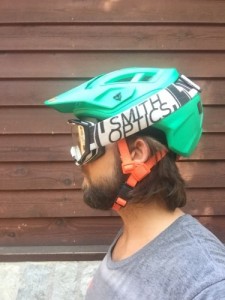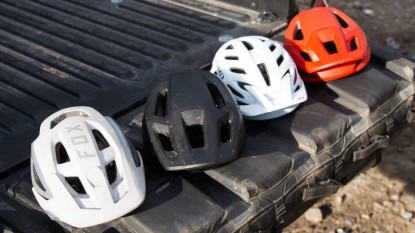Leatt DBX 3.0 All Mountain Review
Our Verdict
Our Analysis and Test Results
Leatt has changed the naming of their trail and all-mountain helmets. The DBX 3.0 All-Mountain is now known as the MTB 3.0 AllMtn and it has undergone some major cosmetic changes since we tested it. -November 2021
In recent years, helmet safety technology has been improving with protective features like rotational impact protection systems, most notably Mips. Most manufacturers have licensed the Mips technology, but a few brands have created their own systems in an attempt to provide the same, if not better, protection for the user. Leatt is one of the brands that has developed a proprietary system, known as Turbine 360. It aims to reduce rotational forces on the brain in the event of an impact, while also absorbing the forces of that impact. We like to see smaller brands on the front lines of safety innovation, and Leatt is helping to lead the charge.
Performance Comparison
Protection
There's more than one way to address impact forces, and Leatt does so with their Turbine 360 system. It uses multiple (10 in the case of the DBX 3.0) 3D molded rings that are made from an energy-absorbing material of Leatt's own development, known as Armourgel. These small blue rings are distributed throughout the inner shell of the helmet and padding and have two primary purposes. The Turbines are designed to work as both a slip plane and an energy absorber. So, Leatt claims that the 360 Turbine system can reduce rotational acceleration by up to 40%, while also reducing linear head impact by up to 30%.
The SPIN system developed by POC and used in the POC Tectal Race SPIN is intended to work similarly, providing protection for both impact and rotational forces. 6D's ODS system found in the ATB-1T Evo also claims to perform similarly but with a completely different design. The industry-standard Mips, found in the majority of helmets, only protects from the rotational forces.
Testers felt that the DBX 3.0 sits a little high on the head. The temporal lobe coverage is less than that of our fullest coverage half-shell helmets like the POC Tectal Race SPIN, or the Specialized Ambush with ANGi, but the back of the shell drops down quite far to provide ample coverage over the occipital lobe.
Comfort
Testers found the DBX 3.0 to be quite comfortable but also felt that it sits fairly high on the head when compared to some of the other models in the test. The coverage on the sides, by the temples, was limited, but there was good coverage on the back of the head. Testers found themselves attempting to push the helmet down farther on their heads on more than one occasion. Overall, testers preferred the shape and depth of the fit of the POC Tectal Race SPIN, Smith Forefront 2, and Bell 4Forty over the DBX 3.0.
The fit was generally comfortable, with well-placed padding and a highly and easily adjustable retention system. The dial itself is large and user-friendly and can easily be adjusted even with gloves.
The helmet straps and the strap yoke/splitter design are a low point, however, and poorly designed compared to some of our more highly rated competitors. Try as we might we couldn't seem to get the straps into a position that didn't come into contact with our ears. The design of this strap splitter is probably our least favorite aspect of the DBX 3.0 helmet, a far cry from the well-designed straps of the POC Tectal.
Ventilation
Testers found the ventilation of the DBX 3.0 to work well during long sunny ascents in the heat of the day. Airflow felt slightly less than that of the Smith Session but on par with our other well-ventilated helmets like the Giro Manifest, Troy Lee A2, and the POC Tectal Race SPIN.
Ventilation is handled by 18 vents arranged with two long channels that allow air to flow from front to back. These channels also split the inner padding of the helmet, so there are gaps between the pads on either side of the head and those in the center. We noticed that the padding tends to allow less sweat to drip down our faces and onto our sunglasses than the competition. We think that perhaps the ventilation system and separated pad sections are the reason.
Features
As mentioned above, the DBX 3.0 has protective features like their rotational force reduction system known as Turbine 360. In another unique and innovative move, they've also equipped the chinstrap of this helmet with a magnetic buckle. We were a little skeptical of this buckle at first, since the normal plastic type we're all used to seem to work just fine, so why fix it if it's not broken? Some of our testers have used this style of buckle on ski helmets in the past, but the DBX 3.0 was the first time we've seen it on a bike helmet.
There is a very short learning curve for the magnetic buckle. At first, you want to clip it together yourself, but you soon learn to get the two pieces close together, and they finish the job for you. This system allows for one-handed clipping and unclipping of the chinstrap, something you can't do with standard plastic buckles, the clipping anyway. Watch setting the helmet on the ground because the magnet on the chin strap will attract rocks and dirt. It does clean off with a bit of effort. This can be avoided by simply hanging your helmet on your handlebars when you take a break as opposed to setting it on the ground.
The DBX 3.0 also has a quality adjustable visor. It offers a good range of adjustability and flips up high enough to easily rest your goggles underneath it. The DBX 3.0 doesn't have a goggle clip or similar feature, but testers found their goggle straps stayed in place on the back of the helmet regardless.
Weight
The DBX 3.0 weighs in at 383 grams or 13.51 ounces. It's far from the lightest helmet in our test, but you'd be hard-pressed to notice that it weighs 33 grams more than the Specialized Ambush, or 9 grams more than the Smith Forefront 2. You might notice, however, that it weighs almost 100 grams less than the Oakley DRT5, and 132 grams less than the 6D ATB-1T Evo.
The features of the DBX 3.0 — like the Turbine 360, the magnetic chin strap buckle, and the large, adjustable visor — all add to the overall weight. We think it's reasonable considering the performance, protection, and features this helmet has to offer.
Durability
Durability doesn't seem to be an issue for the DBX 3.0. It has a quality in-mold construction with a shell that wraps around the more fragile EPS foam to protect it. The straps and fit adjustment all remain in good working order, and the visor still functions properly. Even the unique magnetic buckle work like new despite lots of testing use.
Value
The DBX 3.0 certainly isn't cheap, although it costs less than quite a few models in this test. For the protection, performance, and features we think it is a good value. It did earn a relatively high score in our testing, and we like their use of unique features like 360 Turbine Technology and a magnetic chinstrap buckle.
Conclusion
The DBX 3.0 is a top-quality all-mountain half shell helmet that has a good design and innovative features. The helmet is comfortable, well-ventilated, and is versatile for a wide range of riding styles. Our testers liked Leatt's innovation and use of their rotational impact protection system, 360 Turbine, as well as the magnetic chinstrap buckle. If you're looking for a comfortable and protective helmet, but you want something a little different, then check out the DBX 3.0.















